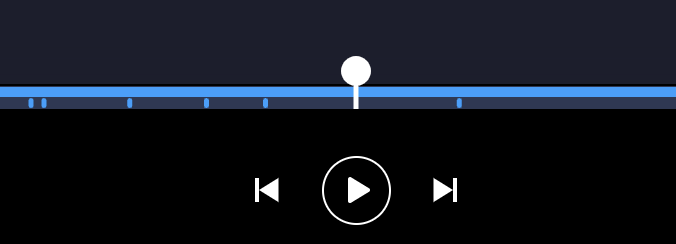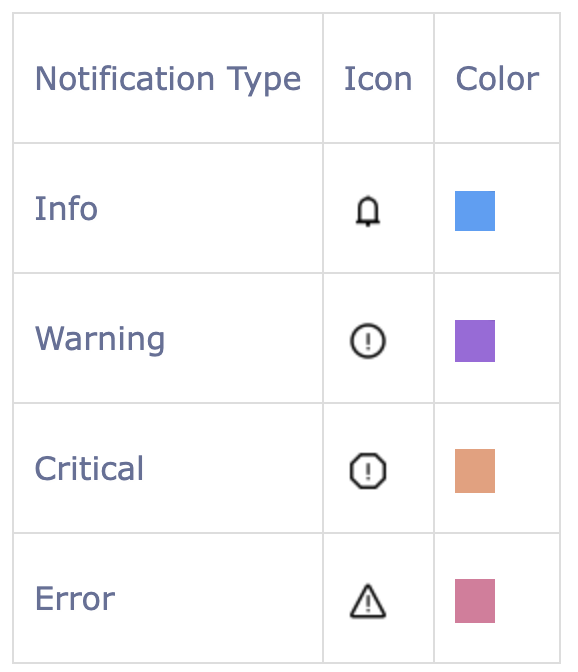Events & alerts
Viewing events
Users can view all events by either navigating through the timeline or going to the events page by clicking on the icon at the top right corner of Formant web application.
The events appear as small ticks on the timeline. Hovering over the event tick displays details about the event and clicking on it opens a menu on the right side of the page.

Events on the timeline.
Clicking on an event on the events page will take the user back to the specific moment in time within the Channel when the event occurred. Users can then navigate to the next or previous event by clicking on the seek button or the event title at the top of the Channel.
On the events page, search, sort, and filter controls are available to help users find a specific event (or events) more quickly. Users can search by username or event message and filter by event type and other relevant tags.
Each event type has a color associated with it, which will be displayed on each row. For events generated by running a command, the user who ran the command and its parameters are displayed as part of the message type. For an event generated by a comment, the user who created the comment is displayed on the message type.
A filter in the channel restricts the notifications displayed in the channel (reducing the alert count and limiting what is displayed in the notification list).
Configuring events
Add Event
To add a new event, go to the burger menu, select Settings ⇒ Events ⇒ Add Event.
From Add Event interface, you can define events that are attached to a specific stream.
Step 1: Describe the event
This is a short description used to define an event. This will be the primary way to distinguish the event when it is displayed on the timeline and events page.
Step 2: Choose devices
Choose the set of devices on which this event should apply to. The device list can be filtered using tags. If a device does not have a tag, it can be created by adding tags to devices.
Step 3: Configure trigger
Event Trigger Type
There are three types of triggers:
- Device comes online
- Device goes offline
- Datapoint evaluation passes from
falsetotrue.
The first two are simple to configure and understand. In the "Event Trigger Type" drop down, simply select them from the dropdown and choose your interval (see below).
Datapoint evaluation triggers are continuously evaluated against incoming datapoints on the selected stream. Evaluation methods are chosen in the "Trigger" section outlined below. If any datapoint evaluates to true against these triggers, then an event will be fired.
Stream
Choose the telemetry stream to monitor. Events defined through this interface is always associated with a stream. Pick the stream that will be used to generate the event. Currently, the product only allows you to select one stream per Event definition.
Interval
The interval decides how often the event will be triggered if it matches the event definition. This is important because the event could be triggered several times and this will help limit the frequency of events. A few notes about the interval:
Event trigger intervals are aligned to the minute/house/day etc. For example, take the following intervals:
| 09:00- 09:59 |
| 10:00 - 10:59 |
| 11:00 - 11:59 |
-
An event configured to trigger hourly can be triggered at 9:59 and at 10:00, but not more than once within 09:xx and not more than once within 10:xx.
-
Updating the event interval may result in a new event being immediately fired (consuming the new interval set).
Events are throttled per device, so if you have N devices running, you can get up to N times the events per stream configured.
Trigger
The type of trigger to be used depends on the stream data type used. See more about stream types here.
| Condition Type | Stream Type | Event Description |
|---|---|---|
| Always (presence) | * | Generate an event when any datapoint arrives on a specified telemetry stream. |
| threshold | numeric | Generate an event when a numeric datapoint exceeds a specified threshold. |
| regex | text | Generate an event when a text datapoint matches a specified regular expression. |
| bit matching | bitset | Generate an event when a bitset key is either true or false or both |
Step 4: Choose actions
Message Format
You can customize event messages via the “Message Format”. Compose a dynamic message using the following template variables: {{event_description}}, {{device_name}}, {{datapoint_value}}.
Notification
Enable notifications if you want to be alerted when this event is triggered. You can also choose the severity of the alert.

Commands
One or more commands can be triggered as part of an event. See Commands for more information on how to expose commands.
Configuration
A configuration template can be triggered when an event occurs. This can be used to trigger ingestion of streams, pause specific streams or change the rate of ingestion of any stream.
Slack Forwarding
You can forward an event to Slack. To do that, first set up the Slack integration by following the docs here. Then turn ON Slack forwarding.
PagerDuty Forwarding
You can forward an event to PagerDuty. To do that, first set up the PagerDuty integration by following the docs here. Then turn ON PagerDuty forwarding.
Webhook Forwarding
You can forward an event to Webhooks. To do that, first set up the Webhooks integration by following the docs here. Then turn ON Webhooks forwarding.
SMS Forwarding
You can forward an event as an SMS to one or more phone numbers listed under the users or service users of your organization within Formant. The SMS message will be sent to all followers of the specific device on which the event occurs. To send SMS, first setup followers of the device and then turn ON SMS forwarding from this page.
Delete Event
From burger menu select Settings ⇒ Events ⇒ Click on the delete button next to the event name to delete an event.
Edit Event
From burger menu select Settings ⇒ Events ⇒ Click on.
From the edit menu, change streams or actions attached to the event.
Updated almost 2 years ago
